length GMC YUKON 2004 Owner's Manual
[x] Cancel search | Manufacturer: GMC, Model Year: 2004, Model line: YUKON, Model: GMC YUKON 2004Pages: 554, PDF Size: 5.21 MB
Page 189 of 554
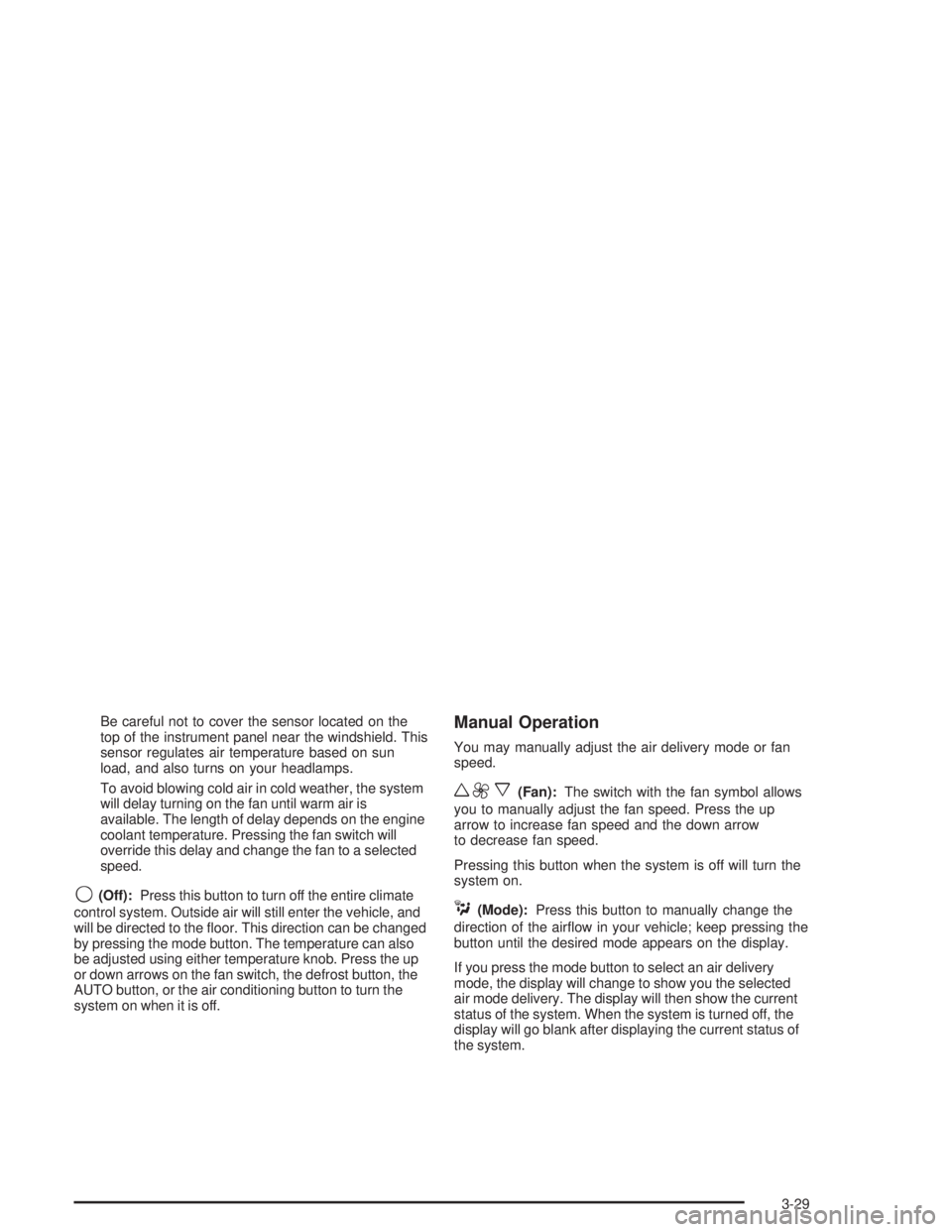
Be careful not to cover the sensor located on the
top of the instrument panel near the windshield. This
sensor regulates air temperature based on sun
load, and also turns on your headlamps.
To avoid blowing cold air in cold weather, the system
will delay turning on the fan until warm air is
available. The length of delay depends on the engine
coolant temperature. Pressing the fan switch will
override this delay and change the fan to a selected
speed.
9(Off):Press this button to turn off the entire climate
control system. Outside air will still enter the vehicle, and
will be directed to the �oor. This direction can be changed
by pressing the mode button. The temperature can also
be adjusted using either temperature knob. Press the up
or down arrows on the fan switch, the defrost button, the
AUTO button, or the air conditioning button to turn the
system on when it is off.
Manual Operation
You may manually adjust the air delivery mode or fan
speed.
w9x(Fan):The switch with the fan symbol allows
you to manually adjust the fan speed. Press the up
arrow to increase fan speed and the down arrow
to decrease fan speed.
Pressing this button when the system is off will turn the
system on.
C(Mode):Press this button to manually change the
direction of the air�ow in your vehicle; keep pressing the
button until the desired mode appears on the display.
If you press the mode button to select an air delivery
mode, the display will change to show you the selected
air mode delivery. The display will then show the current
status of the system. When the system is turned off, the
display will go blank after displaying the current status of
the system.
3-29
Page 303 of 554
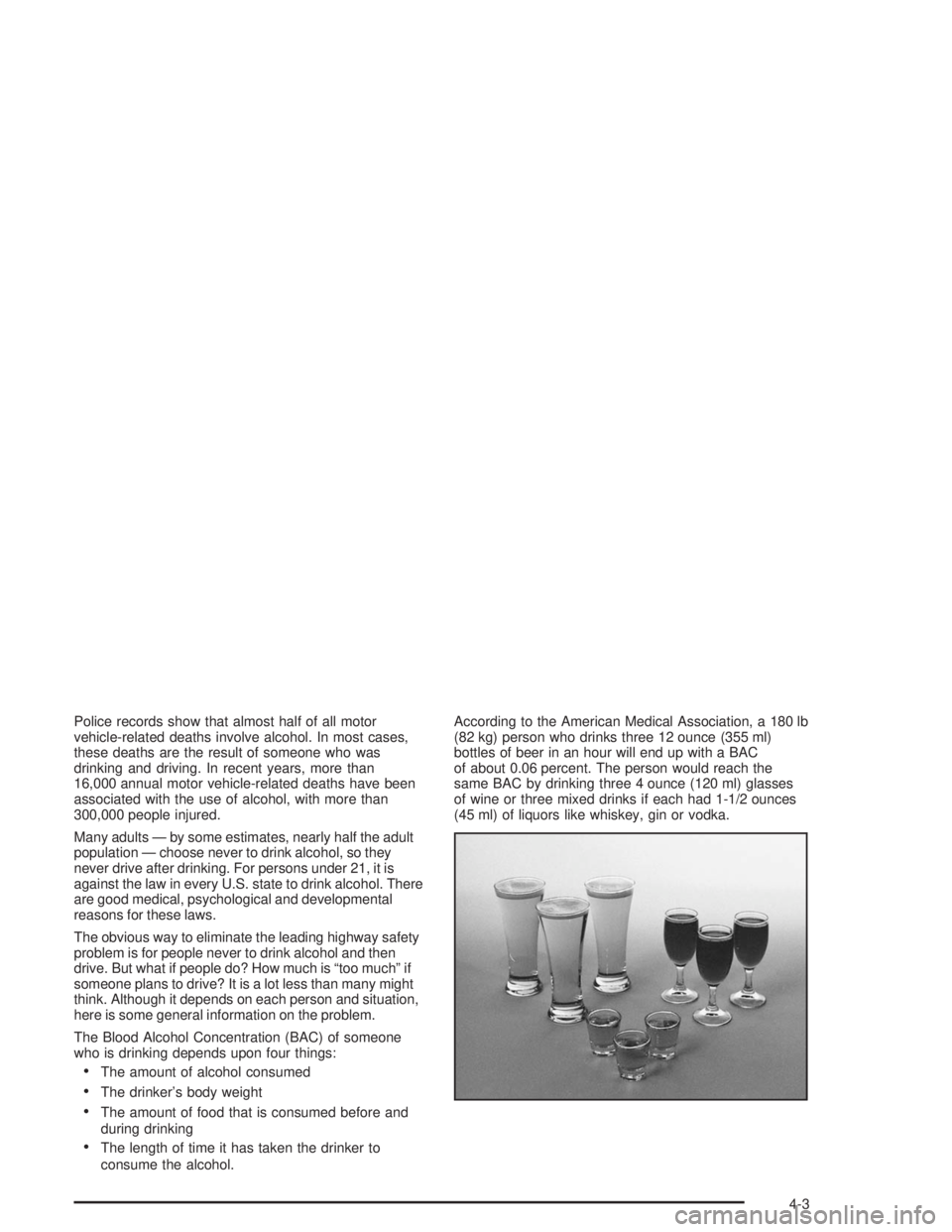
Police records show that almost half of all motor
vehicle-related deaths involve alcohol. In most cases,
these deaths are the result of someone who was
drinking and driving. In recent years, more than
16,000 annual motor vehicle-related deaths have been
associated with the use of alcohol, with more than
300,000 people injured.
Many adults — by some estimates, nearly half the adult
population — choose never to drink alcohol, so they
never drive after drinking. For persons under 21, it is
against the law in every U.S. state to drink alcohol. There
are good medical, psychological and developmental
reasons for these laws.
The obvious way to eliminate the leading highway safety
problem is for people never to drink alcohol and then
drive. But what if people do? How much is “too much” if
someone plans to drive? It is a lot less than many might
think. Although it depends on each person and situation,
here is some general information on the problem.
The Blood Alcohol Concentration (BAC) of someone
who is drinking depends upon four things:
The amount of alcohol consumed
The drinker’s body weight
The amount of food that is consumed before and
during drinking
The length of time it has taken the drinker to
consume the alcohol.According to the American Medical Association, a 180 lb
(82 kg) person who drinks three 12 ounce (355 ml)
bottles of beer in an hour will end up with a BAC
of about 0.06 percent. The person would reach the
same BAC by drinking three 4 ounce (120 ml) glasses
of wine or three mixed drinks if each had 1-1/2 ounces
(45 ml) of liquors like whiskey, gin or vodka.
4-3
Page 333 of 554
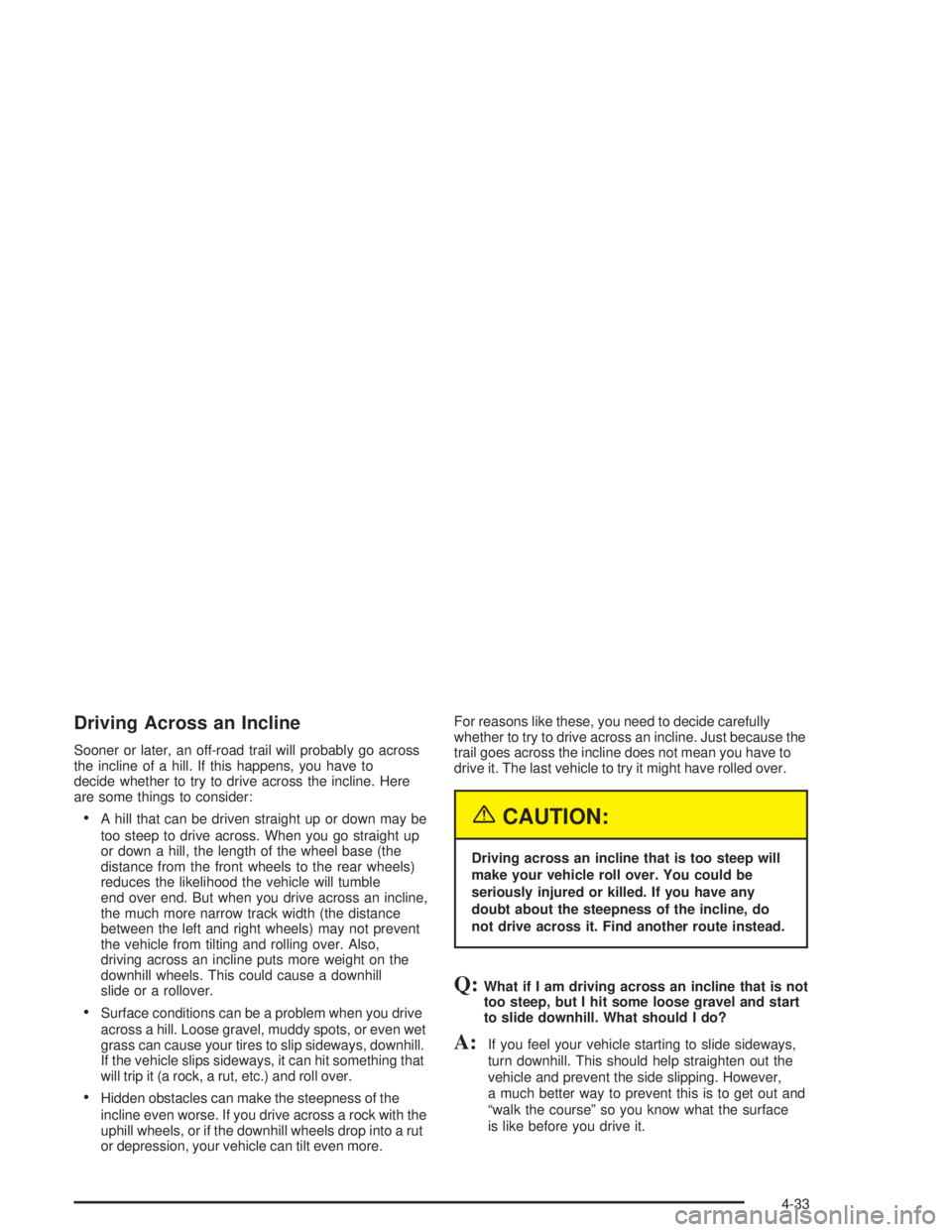
Driving Across an Incline
Sooner or later, an off-road trail will probably go across
the incline of a hill. If this happens, you have to
decide whether to try to drive across the incline. Here
are some things to consider:
A hill that can be driven straight up or down may be
too steep to drive across. When you go straight up
or down a hill, the length of the wheel base (the
distance from the front wheels to the rear wheels)
reduces the likelihood the vehicle will tumble
end over end. But when you drive across an incline,
the much more narrow track width (the distance
between the left and right wheels) may not prevent
the vehicle from tilting and rolling over. Also,
driving across an incline puts more weight on the
downhill wheels. This could cause a downhill
slide or a rollover.
Surface conditions can be a problem when you drive
across a hill. Loose gravel, muddy spots, or even wet
grass can cause your tires to slip sideways, downhill.
If the vehicle slips sideways, it can hit something that
will trip it (a rock, a rut, etc.) and roll over.
Hidden obstacles can make the steepness of the
incline even worse. If you drive across a rock with the
uphill wheels, or if the downhill wheels drop into a rut
or depression, your vehicle can tilt even more.For reasons like these, you need to decide carefully
whether to try to drive across an incline. Just because the
trail goes across the incline does not mean you have to
drive it. The last vehicle to try it might have rolled over.
{CAUTION:
Driving across an incline that is too steep will
make your vehicle roll over. You could be
seriously injured or killed. If you have any
doubt about the steepness of the incline, do
not drive across it. Find another route instead.
Q:What if I am driving across an incline that is not
too steep, but I hit some loose gravel and start
to slide downhill. What should I do?
A:If you feel your vehicle starting to slide sideways,
turn downhill. This should help straighten out the
vehicle and prevent the side slipping. However,
a much better way to prevent this is to get out and
“walk the course” so you know what the surface
is like before you drive it.
4-33
Page 442 of 554
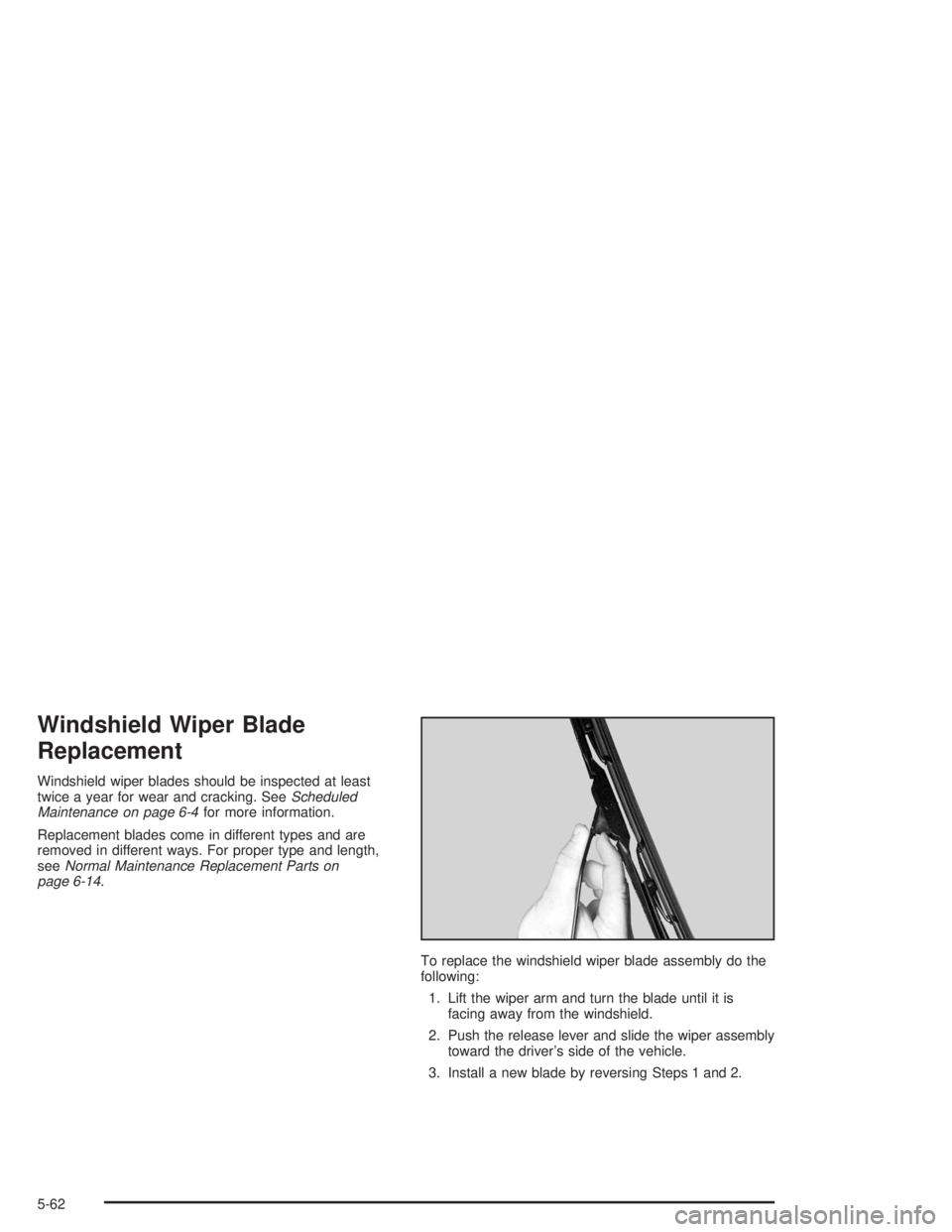
Windshield Wiper Blade
Replacement
Windshield wiper blades should be inspected at least
twice a year for wear and cracking. SeeScheduled
Maintenance on page 6-4for more information.
Replacement blades come in different types and are
removed in different ways. For proper type and length,
seeNormal Maintenance Replacement Parts on
page 6-14.
To replace the windshield wiper blade assembly do the
following:
1. Lift the wiper arm and turn the blade until it is
facing away from the windshield.
2. Push the release lever and slide the wiper assembly
toward the driver’s side of the vehicle.
3. Install a new blade by reversing Steps 1 and 2.
5-62
Page 518 of 554
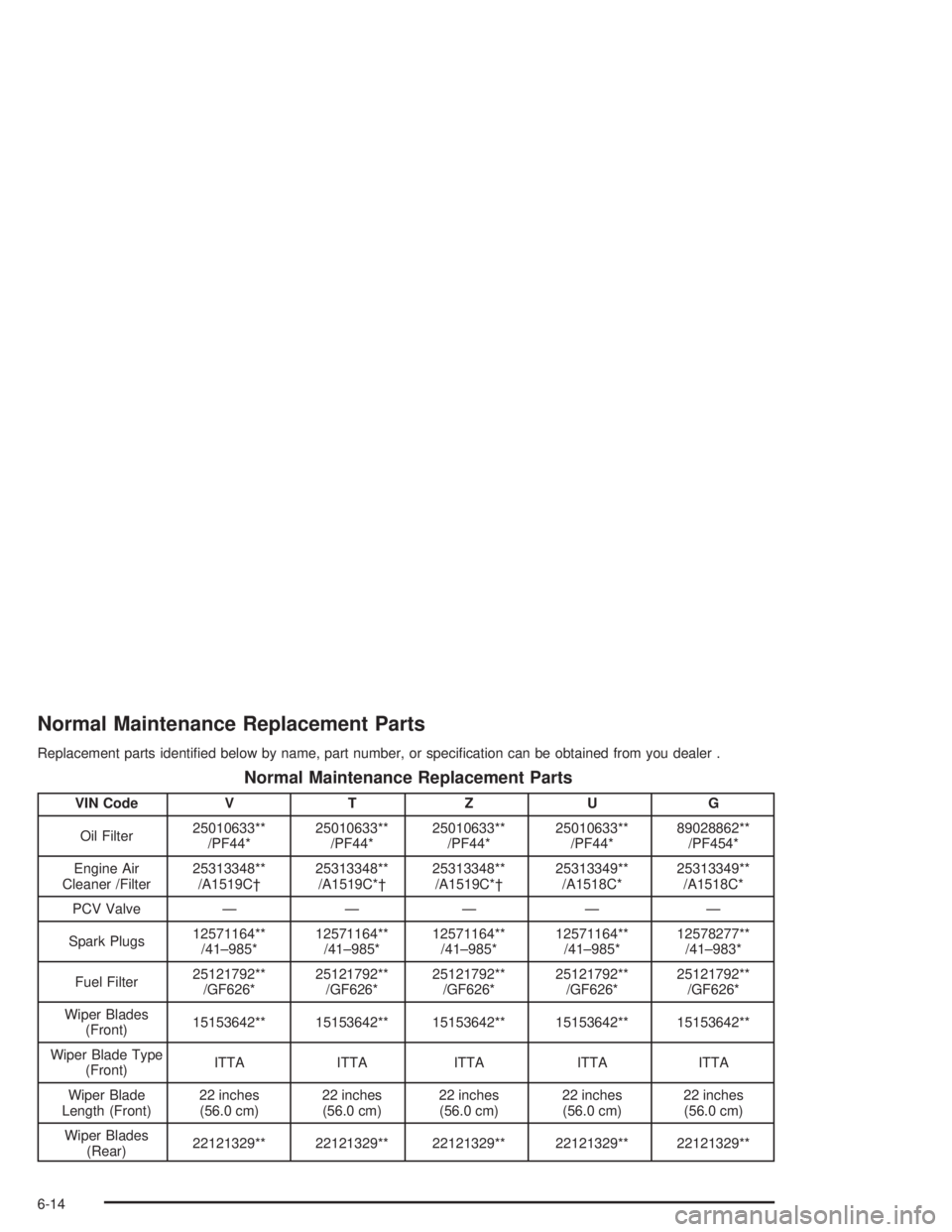
Normal Maintenance Replacement Parts
Replacement parts identi�ed below by name, part number, or speci�cation can be obtained from you dealer .
Normal Maintenance Replacement Parts
VIN Code V T Z U G
Oil Filter25010633**
/PF44*25010633**
/PF44*25010633**
/PF44*25010633**
/PF44*89028862**
/PF454*
Engine Air
Cleaner /Filter25313348**
/A1519C†25313348**
/A1519C*†25313348**
/A1519C*†25313349**
/A1518C*25313349**
/A1518C*
PCV Valve — — — — —
Spark Plugs12571164**
/41–985*12571164**
/41–985*12571164**
/41–985*12571164**
/41–985*12578277**
/41–983*
Fuel Filter25121792**
/GF626*25121792**
/GF626*25121792**
/GF626*25121792**
/GF626*25121792**
/GF626*
Wiper Blades
(Front)15153642** 15153642** 15153642** 15153642** 15153642**
Wiper Blade Type
(Front)ITTA ITTA ITTA ITTA ITTA
Wiper Blade
Length (Front)22 inches
(56.0 cm)22 inches
(56.0 cm)22 inches
(56.0 cm)22 inches
(56.0 cm)22 inches
(56.0 cm)
Wiper Blades
(Rear)22121329** 22121329** 22121329** 22121329** 22121329**
6-14
Page 519 of 554
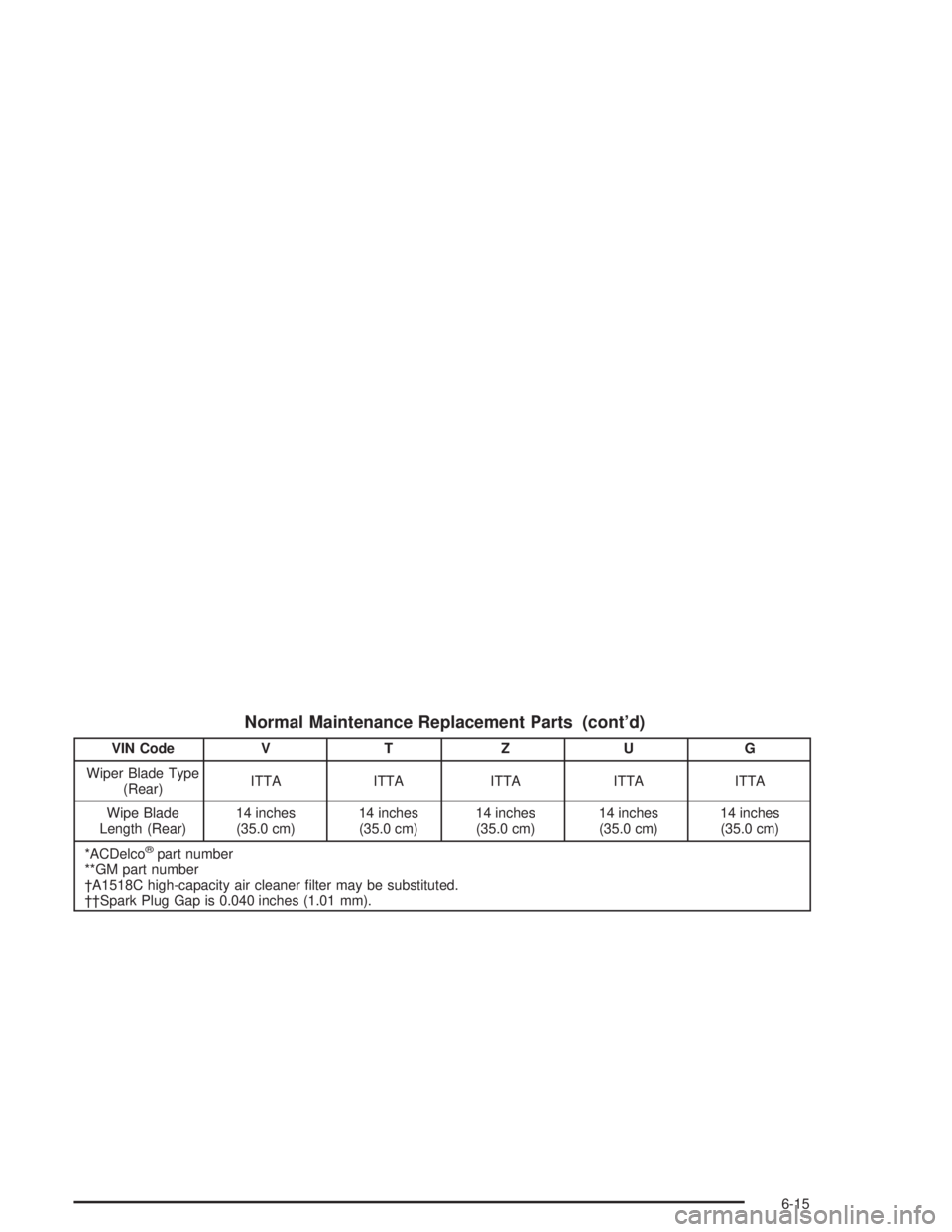
Normal Maintenance Replacement Parts (cont’d)
VIN Code V T Z U G
Wiper Blade Type
(Rear)ITTA ITTA ITTA ITTA ITTA
Wipe Blade
Length (Rear)14 inches
(35.0 cm)14 inches
(35.0 cm)14 inches
(35.0 cm)14 inches
(35.0 cm)14 inches
(35.0 cm)
*ACDelco
®part number
**GM part number
†A1518C high-capacity air cleaner �lter may be substituted.
††Spark Plug Gap is 0.040 inches (1.01 mm).
6-15